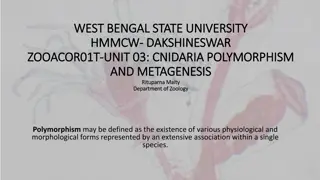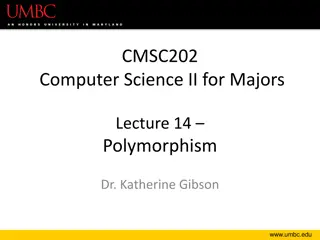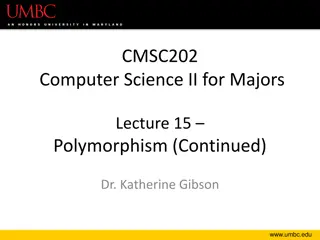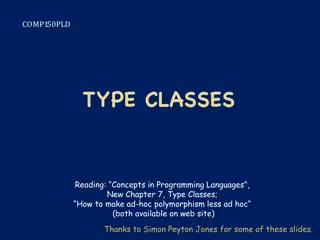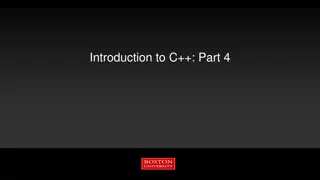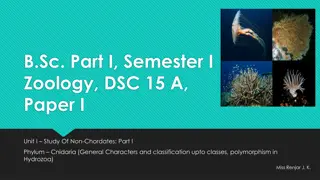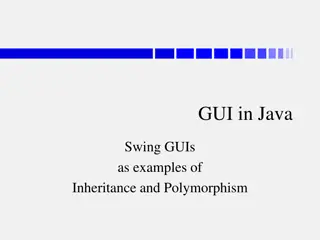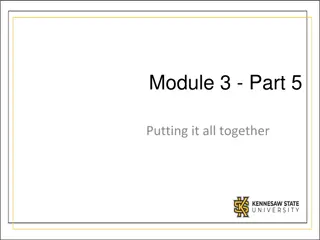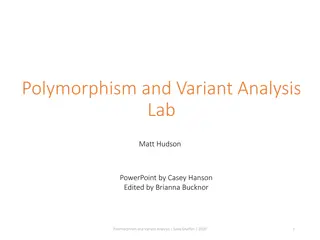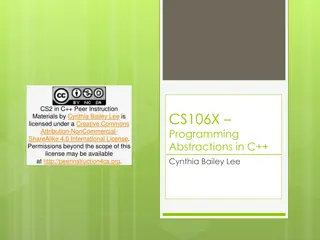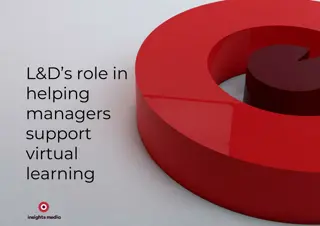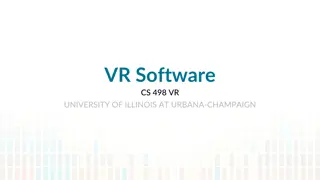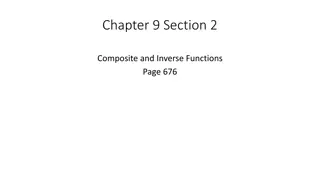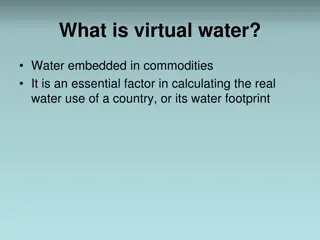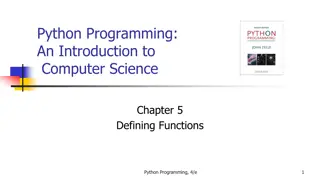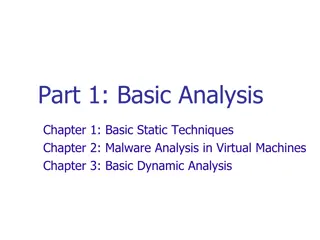Understanding Polymorphism and Virtual Functions in C++
Polymorphism and virtual functions play a key role in C++ programming, allowing for flexibility and extensibility in code through type compatibility, type casts, pointers, inheritance, and overridden functions. By leveraging these concepts, developers can create efficient and maintainable code structures that support complex inheritance hierarchies and facilitate code reusability.
Download Presentation

Please find below an Image/Link to download the presentation.
The content on the website is provided AS IS for your information and personal use only. It may not be sold, licensed, or shared on other websites without obtaining consent from the author. Download presentation by click this link. If you encounter any issues during the download, it is possible that the publisher has removed the file from their server.
E N D
Presentation Transcript
Chapter 15 Polymorphism and Virtual Functions 15-1
15.1 Type Compatibility in Inheritance Hierarchies 15.2 Polymorphism and Virtual Member Functions 15.3 Abstract Base Classes and Pure Virtual Functions 15.4 Composition Versus Inheritance 15-2
15.1 Type Compatibility in Inheritance Hierarchies Classes in a program may be part of an inheritance hierarchy Animal Cat Dog Classes lower in the hierarchy are special cases of those above Poodle 15-3
Type Compatibility in Inheritance A pointer to a derived class can be assigned to a pointer to a base class. Another way to say this is: A base class pointer can point to derived class objects Animal *pA = new Cat; 1-4
Type Compatibility in Inheritance Assigning a base class pointer to a derived class pointer requires a cast Animal *pA = new Cat; Cat *pC; pC = static_cast<Cat *>(pA); The base class pointer must already point to a derived class object for this to work correctly. 1-5
Using Type Casts with Base Class Pointers C++ uses the declared type of a pointer to determine access to the members of the pointed-to object If an object of a derived class is pointed to by a base class pointer, all members of the derived class may not be accessible Type cast the base class pointer to the derived class (via static_cast) in order to access members that are specific to the derived class 1-6
Pointers, Inheritance, and Overridden Functions If a derived class overrides a member function in the base class, and a base class pointer points to a derived class object, then the compiler determines the version of the function to use by the type of the pointer, not by the type of the object. 1-7
Pointers, Inheritance, and Overridden Functions (See inheritance4 code posted on Canvas this is from the main() function) vector<shared_ptr<Person>> people { make_shared<TFaculty>("Indiana Jones", Discipline::ARCHEOLOGY, "Dr."), make_shared<Student>("Thomas Cruise", Discipline::COMPUTER_SCIENCE, nullptr), make_shared<Faculty>("James Stock", Discipline::BIOLOGY), make_shared<TFaculty>("Sharon Rock", Discipline::BIOLOGY, "Professor"), make_shared<TFaculty>("Nicole Eweman", Discipline::ARCHEOLOGY, "Dr.") }; // vector of Person pointers // Person is the base class // Print the names of the Person objects for (int k = 0; k < people.size(); k++) { cout << people[k]->getName() << endl; } // getName() not virtual // so uses base class getName() // function because the pointers // are base class pointers i1-8
15.2 Polymorphism and Virtual Member Functions Polymorphic code: Code that behaves differently when it acts on objects of different types Virtual Member Function: The C++ mechanism for achieving polymorphism 1-9
Polymorphism Animal Consider the Animal, Cat, Dog hierarchy where each class has its own version of the member function id( ) Cat Dog Poodle 15-10
Polymorphism class Animal{ public: voidid(){cout<<"animal";} } class Cat : public Animal{ public: void id(){cout << "cat";} } class Dog : public Animal{ public: void id(){cout << "dog";} } 1-11
Polymorphism Consider the collection of different Animal objects Animal *pA[] = {newAnimal,newDog, newCat}; and accompanying code for(int k=0; k<3; k++) pA[k]->id(); Prints: animal animal animal, ignoring the more specific versions of id() in Dog and Cat because the pointers are type Animal and the id() function is not virtual in the Animal class 1-12
Polymorphism The preceding code is not polymorphic: it behaves the same way even though Animal, Dog and Cat have different types and different id() member functions Polymorphic code would have printed "animaldog cat" instead of "animalanimalanimal" 1-13
Polymorphism The code is NOT polymorphic because in the expression pA[k]->id() the compiler sees only the type of the pointer pA[k], which is pointer to Animal Compiler does not see type of actual object pointed to, which may be Animal, or Dog, or Cat This is called static binding. At compile time, the function associated with the pointer type (base class) is chosen no matter what type of object the pointer is pointing to. 1-14
Virtual Functions Declaring a function virtual will make the compiler check the type of each object to see if it defines a more specific version of the virtual function and will result in late binding, or dynamic binding. This is where the binding takes place at run-time and the function chosen is the one associated with the type of object that the pointer is pointing to. 1-15
Virtual Functions If the member functions id() are declared virtual, then the code Animal *pA[] = {newAnimal, newDog, newCat}; for(int k=0; k<3; k++) pA[k]->id(); will print animaldogcat 1-16
Virtual Functions How to declare a member function virtual: class Animal{ public: virtual void id(){cout << "animal";} } class Cat : public Animal{ public: virtual void id(){cout << "cat";} } class Dog : public Animal{ public: virtual void id(){cout << "dog";} } 1-17
Function Binding In pA[k]->id(), the compiler must choose which version of id() to use: There are different versions in the Animal, Dog, and Cat classes Function binding is the process of determining which function definition to use for a particular function call static and dynamic binding 1-18
Static Binding Static binding chooses the function in the class of the base class pointer, ignoring any versions in the class of the object actually pointed to Static binding is done at compile time 1-19
Dynamic Binding Dynamic Binding determines the function to be invoked at execution time Can look at the actual class of the object pointed to and choose the most specific version of the function Dynamic binding is used to bind virtual functions 1-20
Overriding vs. Overloading Recall that overloaded functions have the same name but different parameter lists. If a base class has a virtual member function and a derived class has an overloading member function, use the override key word at the end of the function header or prototype to indicate that it should be treated as an overriding function. 1-21
Overriding vs. Overloading Overloading (pr15-04.cpp): class Base { public: virtual void functionA(int arg) const { cout << "This is Base::functionA" << endl; } }; class Derived : public Base { public: virtual void functionA(long arg) const { cout << "This is Derived::functionA" << endl; } }; 1-22
Overriding vs. Overloading Overriding (pr15-05.cpp): class Base { public: virtual void functionA(int arg) const { cout << "This is Base::functionA" << endl; } }; class Derived : public Base { public: virtual void functionA(int arg) const override { cout << "This is Derived::functionA" << endl; } }; 1-23
The final Key Word and Overriding The key word final can be used at the end of the header or prototype of a function in an inheritance hierarchy if you want to ensure that no classes below this one override this function. virtual void message() const final; If an attempt is made to override this function in a derived class, a compiler error will occur. 1-24
15.3 Abstract Base Classes and Pure Virtual Functions An abstract class is a class that contains no objects that are not members of subclasses (derived classes) For example, in real life, Animal is an abstract class: there are no animals that are not dogs, or cats, or lions 1-25
Abstract Base Classes and Pure Virtual Functions Abstract classes are an organizational tool. They are useful in organizing inheritance hierarchies Abstract classes can be used to specify an interface that must be implemented by all subclasses 1-26
Abstract Functions The member functions specified in an abstract class do not have to be implemented The implementation is left to the subclasses In C++, an abstract class is a class with at least one abstract member function 1-27
Pure Virtual Functions In C++, a member function of a class is declared to be an abstract function by making it virtual and replacing its body with = 0; class Animal{ public: virtual void id() = 0; }; A virtual function with its body omitted and replaced with = 0; is called a pure virtual function, or an abstract function 1-28
Abstract Classes An abstract class can not be instantiated An abstract class can only be inherited from; that is, you can derive classes from it Classes derived from abstract classes must override all pure virtual functions with concrete member functions before they can be instantiated 1-29
Abstract Classes class Shape { protected: int posX, posY; public: virtual void draw() const = 0; void setPosition(int pX, int pY) { posX = pX; posY = pY; } }; class Rectangle : public Shape { public: virtual void draw() const { cout << "Drawing rectangle at " << posX << " << posY << endl; } }; class Hexagon : public Shape { public: virtual void draw() const { cout << "Drawing hexagon at " << posX << " << posY << endl; } }; 1-30
Abstract Classes int main(){ // Create vector of pointers to Shapes of various types vector<shared_ptr<Shape>> shapes { make_shared<Hexagon>(), make_shared<Rectangle>(), make_shared<Hexagon>() }; // Set positions of all the shapes int posX = 5, posY = 15; for (int k = 0; k < shapes.size(); k++) { shapes[k]->setPosition(posX, posY); posX += 10; posY += 10; }; // Draw all the shapes at their positions for (int j = 0; j < shapes.size(); j++) { shapes[j]->draw(); } return 0; } 1-31
15.4 Composition vs. Inheritance Inheritance models an 'is a' relation between classes. An object of a derived class 'is a(n)' object of the base class Example: an UnderGrad is a Student a Mammal is an Animal aPoodleis aDog 1-32
Composition vs. Inheritance When defining a new class: Composition is appropriate when the new class needs to use an object of an existing class Inheritance is appropriate when objects of the new class are a subset of the objects of the existing class, or objects of the new class will be used in the same ways as the objects of the existing class 1-33
Composition vs. Inheritance Inheritance (pr15-07.cpp): // Base class class Dog { protected: double weight; public: Dog(double w) { weight = w; } virtual void bark() const { cout << "I am a dog weighing << weight << " pounds." << endl; } }; // A SheepDog is a special type of Dog class SheepDog : public Dog { int numberSheep; public: SheepDog(double w, int nSheep) : Dog(w) { numberSheep = nSheep; } void bark() const override { cout << "I am a sheepdog weighing << weight << " pounds \n and guarding << numberSheep << " sheep." << endl; } }; 1-34


